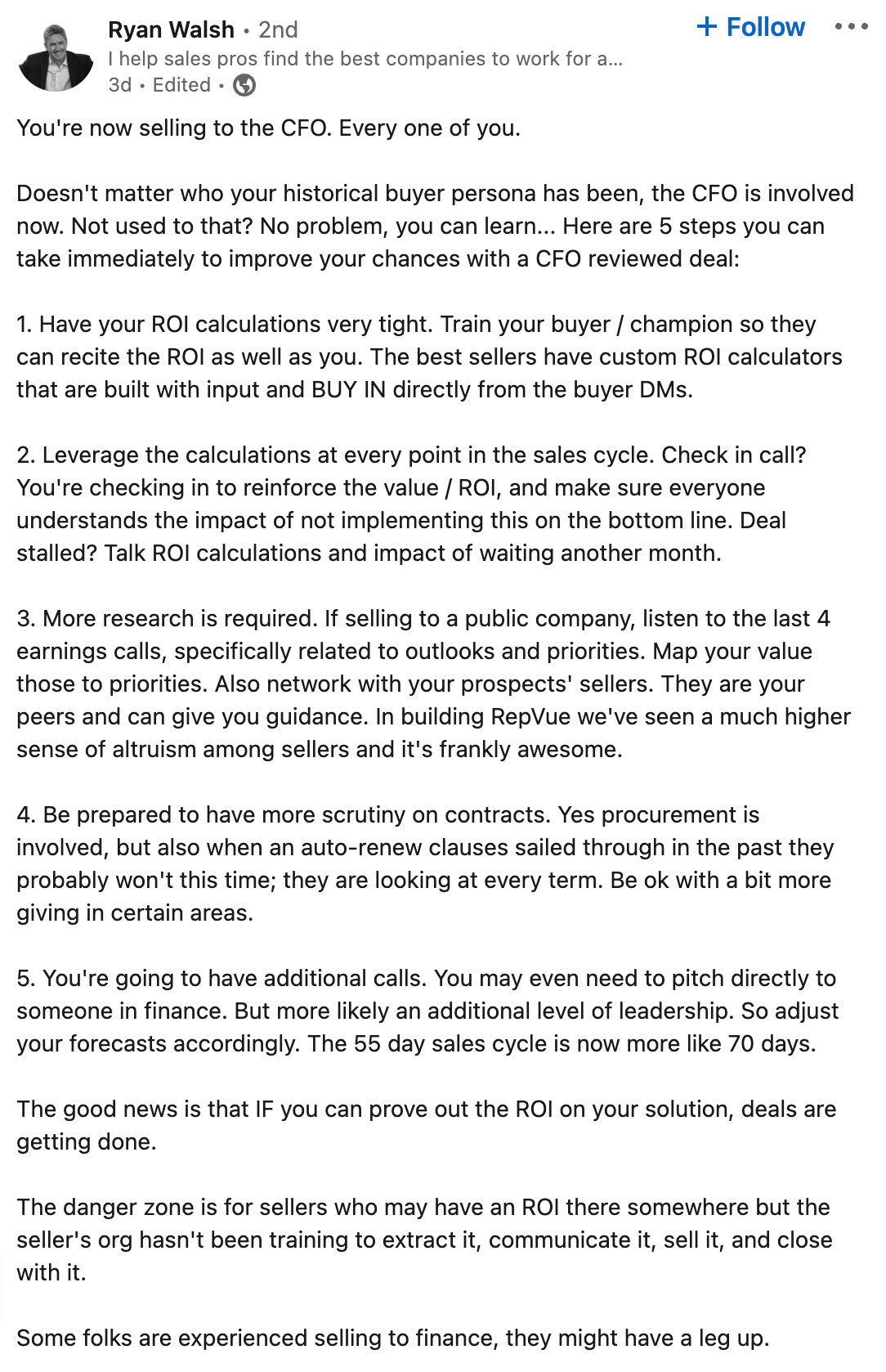Finance: Your Ticket to Win Sales
How to read a 10k report to win the sale
“10k?”
This question, paired with an expression of confusion, was from an MBA graduate who just recently wrapped up an investment project with their cohort.
All I could think was that this person just spent $150k on an education yet doesn’t know about one of the most basic financial documents there is. So common in fact that EVERY single US public company IS REQUIRED to share it.
I’m not here to question the value of an MBA. The realization that struck me was that most people don’t know what this document is. Even in sales.
Given macroeconomic environment factors, heavy scrutiny from buyers (especially finance departments), and procurement platforms like Vendr, or Tropic, it’s clear that sales teams need to be buttoned up.
Ryan Welsh recently posted this:
Most sales people don’t do #3.
Last week I walked through how to do research, so today I’ll cover:
What is a 10k
How to read a 10k
Applications
What is a 10k?
For quick reference, I’m NOT a finance guy. I was never the academic type and I’ve failed subjects in HS and college like: Calculus, Algebra II, and Accounting. I’m only sharing this to point out the fact that if I can read this document - anyone can. Including you.
A 10k is report that is published annually by US public companies to provide both current and prospective shareholders a snapshot of its financial performance.
You’ll find this document in every single public company website by navigating to investors or SEC filings.
When you open it, you’ll find it’s massive. This can be intimidating at first but there’s really only three sections that you have to pay attention to.
How to Read a 10k
The sections that will provide you the most value for your time are going to be:
Section 1 typically labeled “Business”.
Section 7 typically labeled “Management Discussion and Analysis”
Section 7a typically labeled “Quantitative and Qualitative Disclosures About Risk”
I built out a pharmaceutical vertical at my last company. The value of understanding these documents was the following:
Build a business hypothesis of how I could potentially help a prospect
Come to call prepared with 2 - 3 questions that got right to the heart of qualifying or disqualifying a prospect
Leverage customer stories from past clients to show case how I could help in those scenarios.
Here is a quick video walking through an example of how I’d break down a 10k.
This can also be applied in multiple scenarios.
Application:
It’s not just prospecting or discovery calls. Yes, doing your research and understanding the prospect you’re talking to will help you to run a better sales call, and with it, a better sales process.
Here’s some scenarios that you’ll get added benefit:
If the information isn’t in the 10k, you’ll now be able to do deeper research into a problem and then ask more pointed questions. Ie maybe supply chain is an operational risk at a company. At a high level, it’s being discussed in section 7a. If you don’t have all the information, you now have a signal of where to dig deeper and refine your questions further.
Allow you to efficiently use time on discovery or cold calls to get RIGHT to the point.
You can use this same strategy for interviews
Then use it to ask better questions to current or former members of the team
Or ask more pointed questions about a specific business unit.
All in all, it’s just a good life skill to have.
Sales is a powerful skill to have under your belt. Being financially literate is as well. If you’re able to better understand basic business mechanics, it’ll make you a better investor. Investing requires you to know how to understand a balance sheet, then ask questions to better understand the path to commercial success.
The investment “hat” will help you in your career by allowing you to better understand roles that will strategically place you in a position for success. Additionally, it’ll make you a better sales person in YOUR role.
If you have any questions, feel free to chat me here, or shoot me a DM on Twitter.
As Always, thanks so much for reading and see you next week.
-Andrew Kobylarz


